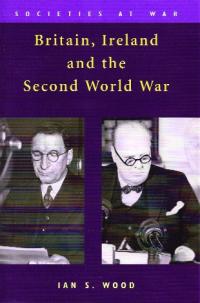Britain, Ireland and the Second World War
Published in 20th-century / Contemporary History, Book Reviews, Issue 1 (Jan/Feb 2011), Reviews, The Emergency, Volume 19
Britain, Ireland and the Second World War
Ian S. Wood
(University of Edinburgh Press, £70)
ISBN 9780748623273
In 1957 David Gray, the US wartime minister to Ireland, wrote publicly that Taoiseach Eamon de Valera ‘maintained a neutrality, which served only Hitler’s objectives’. Ian Wood quotes Gray’s comment but never seeks to get behind it. Gray played an integral part in a conspiracy involving both Winston Churchill and President Franklin Roosevelt to distort the true nature of Irish neutrality by depicting de Valera as unhelpful to the Allies. They sought to discredit him in order to ensure that he could not cause trouble over partition after the war. Dr Wood, who is particularly good in relation to Northern Ireland, demonstrates that Irish policy was not pro-Nazi but pro-Allied in many ways. Much of his study is based on secondary works, with the result that the book overlooks the details of a considerable amount of the secret Irish cooperation and thus misses the crucial point that Irish policy was secretly so benevolent towards the Allies that it was not neutrality at all.
At the start of the war de Valera told the British representative, Sir John Maffey, that Ireland would provide all possible help short of war. It was arranged that Irish coast-watching stations would report to Dublin by radio so that the British could listen in. This may have appeared even-handed, as the Germans could listen in too, but they were too far away to act on the information. Later, all reports were encrypted in a code secretly supplied by the British. Thus the Irish were effectively reporting directly to Britain. The Royal Navy was permitted to station the Robert Hastie, an armed tug, at Killybegs, Co. Donegal, for air–sea rescue purposes, and the British were offered similar facilities at Cobh and Berehaven. The British sailors had only to cover the guns and wear civilian clothes while in port. The British were secretly allowed to set up radar stations near Schull, Co. Cork, and near Malin Head, Co. Donegal. In addition, they were allowed to station a spotter aircraft at Foynes to look for German U-boats. Those were only some of the ways in which the Irish quietly helped.
The author notes that as early as 1920 de Valera publicly stated that:
‘an independent Ireland would see its own independence in jeopardy the moment it saw the independence of Britain seriously threatened. Mutual self-interest would make the people of these two islands, if both independent, the closest possible allies in a moment of real national danger to either.’
De Valera was secretly prepared to help the British, as long as they respected Irish independence. But Churchill was unwilling to acknowledge that independence even privately. Wood notes that some people attributed Churchill’s attitude to ‘an essentially imperialistic mindset, which made it difficult for him to recognise Irish political nationhood’.
The author notes that the Dominions Office suggested that the denial of Irish bases was responsible for the sinking of 368 ships and the loss of 5,070 crew. He does not ask why the Dominion Office rather than the Admiralty drew up those figures. One wonders whether they include the sinking of the Royal Oak at anchor at Scapa Flow, with the loss of 833 lives, in October 1939? Following that sinking, Churchill, then first lord of the Admiralty, called on the British cabinet to authorise the seizure of Berehaven, which could no more have provided protection for Scapa Flow than it could have helped to protect Pearl Harbour against the Japanese.
After the fall of France, Atlantic convoys could not use the sea route around the south of Ireland because it was too vulnerable to attacks from German aircraft and U-boats based in France. Convoys therefore went around Northern Ireland, where the Allies had bases. To facilitate the British, de Valera authorised aircraft using the base on Lough Erne to fly over Donegal, the most direct route to the Atlantic.
In 1943 Gray persuaded Roosevelt and Churchill to ask de Valera for bases in order to get his refusal of an American request on record, so that he could later be depicted as unhelpful. Both the British and the American military objected to the request because they feared that de Valera might comply, and they warned that Irish bases would only be a liability.
In 1944, when the Americans proposed calling for the removal of the German diplomats from Dublin, MI5 objected that this might actually compromise Allied security. MI5 had been feeding misinformation to the Germans in Dublin and was then reading the messages en route to Berlin. The Irish had compelled the German legation to surrender its radio transmitter, so its only means of communication with Berlin was via a telegraph cable to Berne that passed through London, where the British were reading the messages, having broken the German code. Hence MI5 did not want the German diplomats withdrawn.
Its American counterpart, the Office of Strategic Services (OSS), knew that the whole thing was just a political ploy to discredit de Valera, so it was not involved in the infamous ‘American note’ of February 1944. William J. Donovan, the head of the OSS, warned Roosevelt, however, that a second note could complicate some extraordinary secret Irish intelligence cooperation. With the connivance of de Valera, Irish diplomats on the Continent were providing information to the OSS, which was effectively using them as American spies. While the book provides many useful insights into what was happening in Ireland, it fails to show that so-called neutrality was really just a convenient myth that allowed the country to stay out of the conflict while secretly helping the Allies. HI
T. Ryle Dwyer’s Behind the Green Curtain: Ireland’s phoney neutrality during World War II (Gill and Macmillan) is now available in paperback.
















